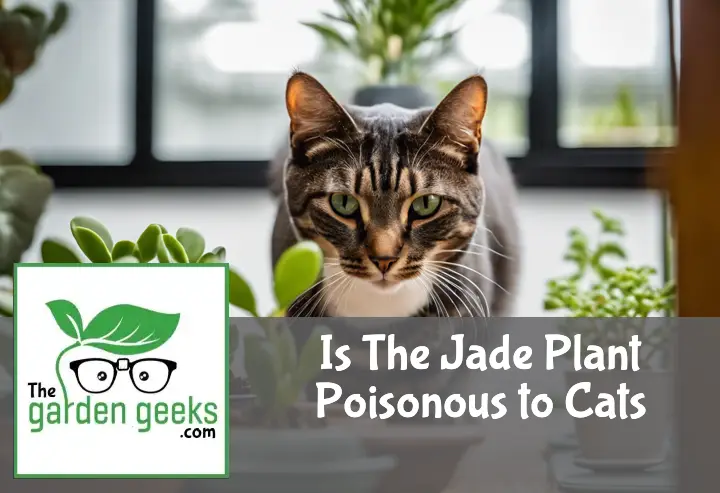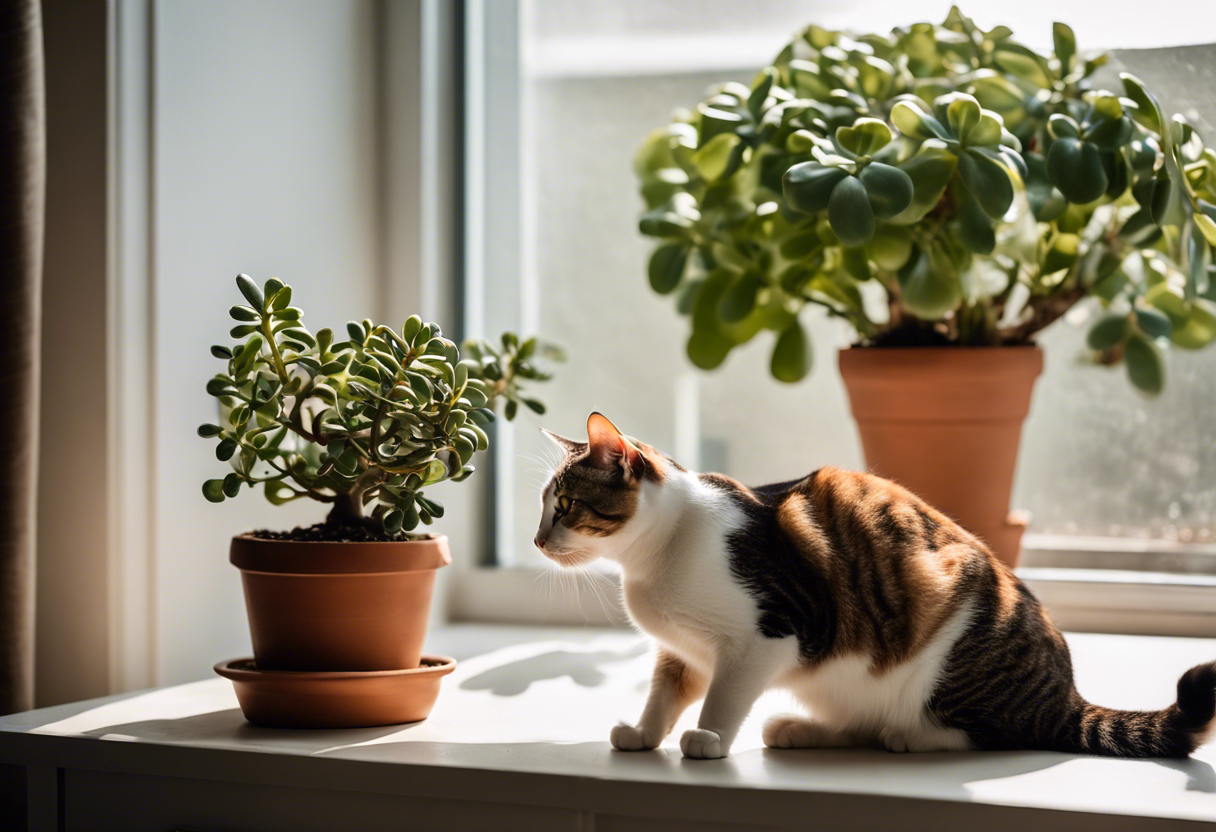Hey there, fellow cat parents! Ever find yourself wondering, Is The Jade Plant Poisonous to Cats? If so, you’re in the right place.
You know how it is, one minute you’re admiring your beautiful jade plant and the next, your furball is giving it the ole’ sniff test. Makes you question, “Is this safe?” Keep reading to find out!
Key Takeaways
- Jade plants are indeed poisonous to cats.
- Ingestion can lead to symptoms like vomiting, depression, and incoordination.
- The toxic component is unknown but it affects the cat’s digestive system.
- Immediate veterinary care is necessary if a cat ingests any part of a jade plant.
- Prevention is key: keep jade plants out of reach or consider non-toxic alternatives for houseplants.
What is a Jade Plant?
Well, let’s get down to the nitty-gritty. A jade plant, folks, is a succulent that’s as tough as nails and just as pretty. It’s a popular houseplant worldwide due to its easy care and beautiful appearance. Understanding jade plants isn’t rocket science – they’re low maintenance, resilient, and can live for many years with proper care. Now that you’ve got the basic jade plant facts, let’s dive deeper into this green beauty.
Origin and Description of Jade Plant
The jade plant hails from South Africa – yes, the land of safaris and sunsets! It’s known for its thick, woody stems and shiny, plump leaves that resemble precious jade stones (hence the name). The physical characteristics of jade plants are quite distinctive. They have oval-shaped leaves that are rich green in color and often have red edges when exposed to direct sunlight.
Now picture this: A mature jade plant can grow up to 6 feet tall indoors! Imagine having your very own mini tree at home. That’s what owning a jade plant feels like. So now you know where do jade plants come from and what they look like.
Common Varieties of Jade Plants
There are several types of jade plants, each with their unique charm. The most common one is Crassula ovata, also known as the money tree (who wouldn’t want one of those?). This variety has glossy green leaves that can turn reddish in full sun.
Another popular type is the ‘Hobbit’ or ‘Gollum’, named after characters from J.R.R Tolkien’s novels due to their oddly shaped leaves. These guys have tubular green leaves with red tips – quite a sight!
And then there’s the ‘Variegata’, which stands out with its cream-striped leaves. Each of these common jade plant varieties has its unique features, making them a great addition to any indoor garden. So there you have it – a quick guide to identifying different jades.
Is the Jade Plant Poisonous to Cats?
Well, let’s cut to the chase. The answer is yes, jade plant toxicity is a real thing and it can cause cat poisoning. This common houseplant might look harmless, but it’s one of those harmful houseplants that could pose a risk to your feline friend’s health.
Toxic Components in Jade Plants
Jade plants contain toxins that are harmful to cats. The main culprit here is a substance called calcium oxalate. It’s found in all parts of the plant and can cause some serious discomfort if your cat decides to take a nibble.
But wait, there’s more! These plants also have another nasty component – terpenoids. These substances can cause vomiting, depression, and even ataxia (that’s a fancy term for loss of coordination) in cats. So yeah, jade plant dangers for cats are pretty real.
How Cats Might Interact with Jade Plants
Now you might be thinking, “My cat isn’t interested in my plants.” Well, don’t be so sure about that! Cats are curious creatures by nature and they love exploring their environment. This includes sniffing around your jade plant.
And what happens when they get too close? They might just take a bite out of curiosity or even rub against the leaves. Both these actions expose them to the toxic components of the jade plant.
So remember folks, while we love our greenery indoors, we need to think about pet safety and our furry friends’ feline health too! Keep an eye on your kitty around any plants and make sure they’re not getting into any leafy trouble!
What are the Symptoms of Jade Plant Poisoning in Cats?
When it comes to jade plant toxicity, our feline friends can have a rough time. If you’re wondering, “Is The Jade Plant Poisonous to Cats?“, the answer is a resounding yes! Now let’s dive into those pesky cat poisoning symptoms.
Physical Symptoms
If your cat has had an unfortunate encounter with a jade plant, you might notice some physical signs. One of the first things you’ll see is vomiting in cats. It’s not pretty, but it’s a clear sign something’s up.
Next up on the symptom list is feline diarrhea. Not exactly dinner table talk, but important to know nonetheless. If your kitty’s litter box habits take a turn for the worse after nibbling on a jade plant, it could be due to jade plant ingestion.
But wait, there’s more! You might also spot some jade plant skin irritation or even excessive drooling. Yep, that’s right – we’re talking about excessive drooling in cats here!
Last but not least, if your usually energetic furball suddenly becomes lethargic or unresponsive, that’s another red flag. So keep an eye out for any signs of lethargy in cats, especially if they’ve been around jade plants.
Behavioral Changes
Now onto behavioral changes. This can be trickier to spot because every cat has its quirks, right? But trust me, when it comes to cat behavior after poisoning, there are certain things you should look out for.
First off – changes in appetite. If Mr Whiskers suddenly turns his nose up at his favorite tuna treat after coming into contact with a jade plant… well that’s definitely unusual feline behavior!
Another thing to watch out for is increased aggression or irritability. If your usually cuddly kitty starts hissing or swiping at you, it could be a sign of feline jade plant exposure.
And lastly, keep an eye on their sleep patterns. If your cat is sleeping more than usual or seems restless during their normal nap times, this could indicate a problem. Remember, abnormal sleep patterns in cats can be a sign of discomfort or distress!
How is Jade Plant Poisoning Diagnosed and Treated in Cats?
When your feline friend starts acting all weird, you might wonder, Is The Jade Plant Poisonous to Cats? Well, let’s dive into the nitty-gritty of diagnosing and treating jade plant poisoning in cats.
Diagnostic Procedures
So, how does a vet diagnose jade plant poisoning diagnosis in cats? It usually begins with a thorough physical examination. Vets look out for telltale signs like vomiting or lethargy which are common symptoms of jade plant poisoning.
If your cat has been around a jade plant recently or if there’s evidence of chewed leaves, that’s another red flag. But it doesn’t stop there. To confirm their suspicions, vets may run some diagnostic tests. These could include blood work or urinalysis to check for any abnormalities caused by cat jade plant ingestion.
Treatment Options and Recovery Process
Once the diagnosis is confirmed, what next? The treatment! The main goal here is to get rid of the toxins from your cat’s system ASAP. This might involve inducing vomiting or administering activated charcoal to absorb the toxins – all part of the treatment for cat jade plant ingestion.
In severe cases, your furball might need intravenous fluids to prevent dehydration and help flush out the toxins faster. Now comes the recovery process which can be quite a journey depending on how much of the jade plant your kitty nibbled on.
With proper veterinary care and lots of love (and maybe some extra treats), most cats bounce back just fine from jade plant toxicity. So don’t panic! Just remember to keep those pesky jade plants outta reach next time!
How Can You Prevent Your Cat from Ingesting a Jade Plant?
When it comes to preventing cat ingestion of jade plants, there are a few strategies you can employ. The key is to understand the jade plant dangers and take proactive steps.
Safe Placement of Houseplants
Firstly, let’s talk about houseplant safety. Cats are curious creatures, so keeping plants away from their reach is crucial. Consider using high shelves for plants or even hanging planters. These options can make your greenery less accessible to your feline friends.
Also, think about cat-proofing your plants by placing them in rooms that your cats don’t frequent. This way, you’re reducing the chances of them getting into a tussle with your jade plant.
Alternative Non-Toxic Houseplants for Cat Owners
Now, if you’re still worried about the whole “Is The Jade Plant Poisonous to Cats” situation, why not consider some non-toxic houseplants? There are plenty of cat-friendly plants out there that won’t cause harm if ingested.
For instance, spider plants and Boston ferns are great pet-safe greenery options. They’re not only safe indoor plants for pets but also add a lovely touch of nature to your home without the risk.
Remember folks, it’s all about making smart choices when it comes to our furry friends and their interaction with houseplants!
To Wrap Up
So, to answer the million-dollar question – Is The Jade Plant Poisonous to Cats? Yes, it’s as harmful as a toddler with a permanent marker near your white couch.
Remember, keeping our furry friends safe is like keeping a goldfish out of a shark tank. Let’s do our best to keep them away from any jade plants!



